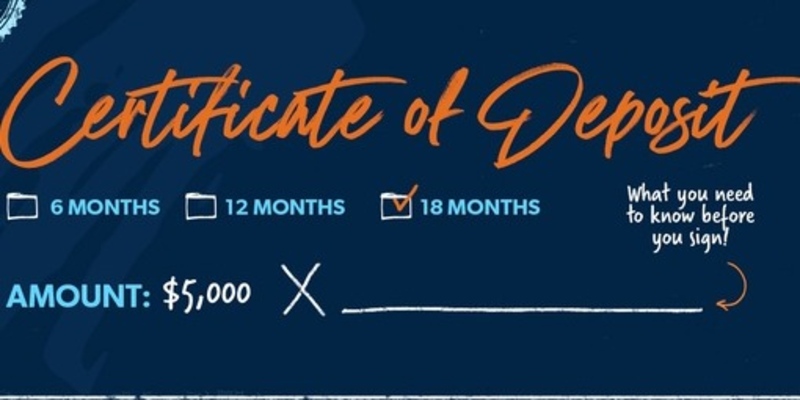A Certificate of Deposit, often known as a CD, is a widely used financial product. It lets people invest their savings for an established period at a set interest rate. This article will go into the specifics of what attributes come with a CD and how it operates. We'll also discuss various types that exist such as high-yield CDs. We will also look into elements that have effects on rates of interest in CDs and assist you in deciding whether or not having a Certificate Deposit fits well within your method for saving money.
What is a Certificate of Deposit?
A Certificate of Deposit, also known as a CD, is what we call money deposited for a specific time at financial businesses such as banks and credit unions. You put one large sum of money in the bank for an agreed length of time. For promise not to take it out during that period, the bank gives you interest on your deposit amount. When you make this deposit the first time, they tell you how long the term will be and how much the interest rate will be usually terms are a few months up to many years.
The main benefit of a CD is its security. As it has backing from the bank that issues it and often gets insurance from governmental bodies such as FDIC in America, this offers an investment with less risk compared to other financial goods. The set rate of interest guarantees that investors are aware of precisely how much they will gain throughout the CD, which makes it attractive for people looking for stability and certainty.
How Does a CD Work?

A CD functions by letting you keep p a certain quantity of money in a financial organization for an established period. This duration, also known as the maturity span, can vary from some months to numerous years and usually has.m higher interest rates for longer spans. You will receive interest on your deposit from the bank but cannot reach the core amount until it matures or penalties may apply if attempted earlier.
When the term finishes, or when the CD gets matured, you will get back your original deposit along with any interest that has been gathered. The gained interest from a CD could be paid in several ways, monthly, every three months (quarterly), yearly - or it can be combined with the main amount to gain more compound interest throughout the term period. However this might happen, normally rates of interest are higher than what standard saving accounts offer. On the other hand, there is no flexibility if wanting access to funds during ongoing term time.
Types of CDs
Different kinds of Certificates of Deposit exist, each one serving diverse investment strategies and aims. Some familiar types comprise traditional CDs, high-yield CDs, and jumbo CDs.
A usual CD is very simple. It gives a set interest rate for a specific time. But high-yield CDs are getting more popular because they can give higher interest rates than normal CDs. These high-yield choices often come from online banks that can provide improved rates due to smaller operating expenses. These are perfect for investors ready to put their money aside for a long period, in return for bigger profits.
A different popular kind is the jumbo CD, which needs a bigger initial deposit, normally $100,000 or above but gives higher interest rates in exchange. For people who want to increase their earnings a large amount of money, a jumbo CD might be an attractive option.
Factors Affecting CD Interest Rates
Several elements influence the interest rate on a CD, particularly market interest rates currently in effect and term duration. Banks modify their CD interest rates according to policy rates set by the Federal Reserve because they display overall economic conditions. In situations where the broader economy's interest rates are higher, banks usually give more competitive CD rates as a strategy to draw deposits.
The duration of the CD is a significant element. Generally, if you choose for a longer period, the interest rate will be higher, but it's not always true. Many financial institutions give promotional rates on CDs with fewer durations to bring in more customers, while rates for long-duration CDs tend to remain steady and foreseeable. To find the best option considering your financial objectives and the current economic situation, it is crucial to look around and compare CD interest rates.
Advantages of Investing in a Certificate of Deposit
A key benefit of putting money in a Certificate of Deposit is the assured profit. Not like shares or mutual funds, the interest rate on a CD stays unchanging, which implies that you are aware of precisely how much wealth you will gain during its duration. This option proves dependable for people who desire to increase their savings with very little danger involved.

Another important advantage is the protection CDs offer. In America, FDIC insurance covers deposits up to a specific sum, making CDs one of the most secure investment tools. This makes it an optimal selection for cautious investors who value safety more than potentially bigger returns. Moreover, the steady interest rates on CDs make them notably attractive in conditions of low interest rates. This is when other investment alternatives might not provide such appealing returns.
If you wish for diversification in your investment portfolio, CDs can also function as a method to achieve balance with more risky assets such as stocks and bonds. Although CDs may not give the high returns of investments that are more unstable, their characteristic of low risk helps form a firm base in a diversified portfolio.
Conclusion
In short, a Certificate of Deposit is a safe and certain method to save and increase your wealth. It gives a stable interest rate with little risk, hence it can be attractive for cautious investors or people who want to establish a steady savings base. Even though the earnings from CD might not be as big as more unstable investments, the tranquility and security it offers could make it an important part of a balanced financial plan. Regardless if you select a high-yield CD or an ordinary one, assessing your financial objectives and searching for the highest available interest rates on CDs is important.







